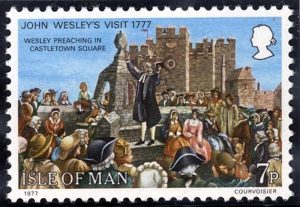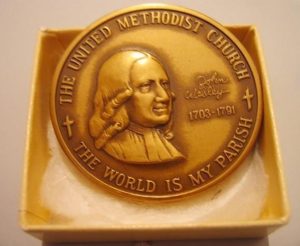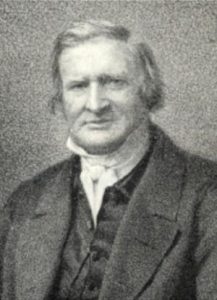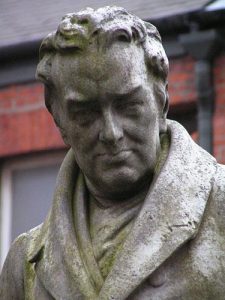Tensions within the Anglican Church
At the beginning of the century there was conflict inside the Church of England between the “High Church”, supported by the (conservative) Tory party, and the “Low Church”, supported by the (liberal) Whig party and more tolerant towards the non-conformists. The debate was over whether or not the non-conformists could be allowed to hold official positions. In 1703, the writer Daniel Defoe, author of the well-known novel Robinson Crusoe, was imprisonedfor having written a pamphlet criticizing High Church supporters, who led the Church at that time.
Methodism
 Postage stamp depicting Wesley preaching
Postage stamp depicting Wesley preaching
 John Wesley
John Wesley
 Charles Cook (1787-1858)
Charles Cook (1787-1858)
John Wesley (1703-1791), his brother Charles and his friend George Whitefield (1714-1770) were the founders of the Methodist movement. It was given this name because of the “method” of prayer and study used by the group of believers these three had gathered together among fellow students at Oxford University. When John Wesley met the Moravian brothers on 24th May 1738, he was “converted”, “born again”. These terms meant a deep spiritual experience assuring the believer that they really had been saved by Christ. This was followed by a large-scale missionary programme both in Great Britain and overseas. George Whitefield made many trips to America, where he established Methodism, preaching to large crowds. Sadly, the issue of predestination caused a conflict between the two men ; Whitefield was closer to the calvinist position, while Wesley preached that God’s grace was given to all – this was similar to the ideas of Jacobus Arminius (1560-1609), a Dutch theologian who had been denounced as a heretic by the Synod of Dordrecht in (1619).
The Anglican Church mistrusted the Methodist style of preaching, which was emotional and enthusiastic. Methodist preachers (including many members of the laity) preached in parishes where they were made welcome, but frequently in the open air, in the workplace, just as Whitefield used to do. They were very popular with the poor. The new converts formed Bible Circles and were encouraged to aim at sanctity in their everyday lives.
The break with the Anglican Church occurred in 1784, when Wesley ordained about a hundred preachers and provided them with a theological guide. The Methodist Church also developed in America, and Charles Cook introduced Methodism to France at the end of the 18th century.
Anglican Evangelicalism
 William Wilberforce © Wilberforce house museum
William Wilberforce © Wilberforce house museum
Paralleling what was happening in the Methodist movement at this time, an Evangelical Revival also took place in the Anglican Church, but it was different in several ways : the Anglicans criticized travelling preachers, preferring to carry out their work within the parish ; they attached great importance to the Bible and their members were rather more middle class than working class.
It was a dynamic movement ; they started up charities, fought for better working conditions, the reform of prisons and, later on, the abolition of slavery, which led to the Act of Emancipation (abolition of slavery) thanks to the continued efforts of William Wilberforce (1759-1833).